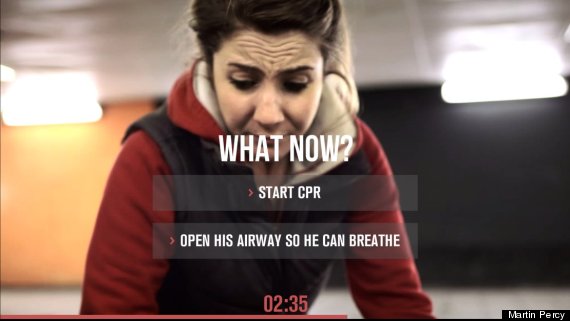
Ever seen an interactive film? If not, take a quick jump to Martin Percy's "Lifesaver," a BAFTA- and Webby-nominated emergency procedural in which you race the clock to try to save a stranger's life.
Done right, interactive video offers a whole new window on story telling -- one that Percy, a well-known British director, has been exploring through pieces for Tate Modern and with Ian McKellen at London's National Theatre. For the film "Lifesaver," he worked with the Resuscitation Council UK, which seeks to educate the public on resuscitation methods.
Percy recently talked to The Huffington Post about "Lifesaver," funding and the future of his budding genre.
So why do you think interactive film -- this tiny niche, not currently popular -- is going to take off?
There’s an interesting parallel with the early days of cinema. The vast majority of early film was this really boring crap. People thought, "We know what this film thing is; it’s a way to distribute theater and musical." So there are cases full of these early movies where people just took one camera, set it in front of a stage, and it rolled while the actors did their thing. It's quick and easy to film a piece of musical -- you need one camera, you just roll. None of this close-up nonsense or tracking shots or panning or anything difficult.
Then people started to have this breakthrough where they said, “Wait, hang on a bit, maybe film isn’t just a way to distribute theater and musical. Maybe it's a medium in its own right.” And movies, real movies came out of that.
I feel like today the majority of online videos are where early film was. But gradually people are going to start using Internet video, Internet-native video, interactive video as a medium in itself, not just as a way to distribute video.
Then why are most interactive films we see these days so awful?
It's so easy to mess up a linear story by adding interactivity to it. Like, how often do you go to a movie and say, "Hey, 'Taxi Driver' was sort of a good movie. I just wish I could have been able to choose the ending?" Never. Never. Nobody does that. But people keep on thinking, "Here’s a video, we’re going to take this story we’ve thought up and add interactivity to it." It just completely messes it up and they’re like, "F**k it, this proves interactive video doesn’t work."
What are your rules of thumb for making a good interactive film?
To make a good interactive film, you need to think of something the user can do and model that with film and interactivity. Think a conversation or emergency procedure or touring a museum. You don't want the user to be stuck in just a straight linear story.
And you want to stay away from stories and scenarios where choosing what the character does makes them uninteresting. A great idea for a terrible interactive film would be an interactive romantic comedy: Do the romantic leads go for each other or not? But, of course, once you start choosing for characters in those stories, you've broken the character, you've broken the story. But other genres, such as survival in its various forms, survival horror, fighting for the survival of someone you love or care about, it’s less based on personality. Everyone would want to survive in that case. Everyone would want to save their loved ones. That makes for a good interactive video.
Let's talk about your interactive films. Why did you decide to create "Lifesaver"?
In 2004, I did a CPR course and it was very nice -- cups of tea, biscuits. ... I could see there were all sorts of problems with this set-up. Talking to the ambulance guy, the really key thing is, in a CPR course there's no screaming, there’s no crying, there’s no vomit, there’s no blood. Friends freaking out -- that always happens. There’s no person lying there about to die. All this training for life saving is not training you for the real nitty-gritty.
We did a bunch of interviews before we made "Lifesaver" with a bunch of ambulance guys, and the thing I’m happiest about in the feedback from "Lifesaver" is the number of ambulance people who’ve spontaneously said, “Oh God, this reminds me of what it’s really like.”

Screenshot from "Lifesaver" asking viewers what should be done in a life-or-death situation.
How hard was it to get "Lifesaver" funded?
It took from 2004 to 2010. Initially I thought, "Putting video and interactivity together to save people’s lives, who is not going to want to fund that?" And 50 percent of the funding came from the Technology Strategies Board in the U.K., who just wanted to fund something, they really didn’t care, something innovative and kind of helpful. Then we went to all these first aid and medical trusts and said, “Look, we’ve already got 50 percent of the money. We only need 50 percent,” and they said, “Noooo, we don’t think so.” And there was five years of that.
Finally we found this tiny charity called the Resuscitation Council. They’re very small, but they’re a group of doctors who decide the regulations for what you should do if someone has a heart attack or if someone choke. ... And they funded this thing, which took the whole budget of their discretionary spending for the year, and they were fantastic, the best partners you could hope for.
What interactive films would you recommend for people curious about the genre?
Interactive video is getting a little rehab at the moment because the most successful genre of interactive video is music videos [and] the problems of story and interaction don’t apply with music videos because the story is the song. [Digital media company] Interlude in New York did the Bob Dylan video "Like a Rolling Stone." So it’s like 16 channels of TV and everyone is singing “Like a Rolling Stone.”
The key problem is that interactive video won’t be fully rehabilitated as a term or form of filmmaking until people trust it to do things other than make music videos. If it’s just good for music videos, it’s fine but it remains a little bit of a sideshow. I think the challenge for it remains that it needs to move out and see what it can do usefully and effectively better than a linear video. There's [production company] Tool of North America, they did “Clouds Over Cuba.” The Kissinger twins are doing fantastic stuff. It’s gradually growing up.